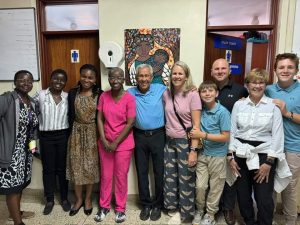Doctor Moses Mwangi Thoughts on Shortage of Essential Vaccines in Kenya
I’m Dr. Moses Mwangi, trained in pharmacy and for over 30 years worked in the vaccine industry and for 16 years was the head of the then World number one multinational vaccine company and with responsibility for about 9 countries in the Eastern Africa.
I was privileged to coordinate the research and commercialisation of a large majority of the vaccines currently in use both in public and private sectors in Kenya and the region.
Vaccines safe lives and are the most important invention that has impacted public health globally in the last 100 years. Where a vaccine exist for any disease of public health importance, using such a vaccine widely is the game changer; that’s why, the world worked so hard to research and find the COVID-19 pandemic vaccine and only then could the global health experts know that the pandemic could be conquered.
When it comes to vaccination of children, there’s a well coordinated global effort that works to ensure that no country is left behind, including the least developed. Diseases know no boundary and need no passport to spread quickly across the globe. The Global Alliance for Vaccines and Immunisation ( GAVI) started in the year 2000 and is well seized of the urgent need to ensure that every child gets access to essential vaccines, no matter their status
Here in Kenya, “after welcoming your newborn, there are certain vaccines that they must receive at birth, at 6 weeks, 10 weeks, 14 weeks, 6 months, and 9 months.” For parents who can afford and their children are seen by paediatricians in private clinics and hospitals, they get to benefit from other important vaccines all the way to 2 years and even beyond.
The Division of Vaccines and Immunisation ( DVI) of the Ministry of Health is responsible for overseeing the Expanded Programme of Immunisation ( KEPI) across the country. This is one program in health that can not and should not and must not be devolved. Vaccines for our children are too important to be placed in many hands, some of which could be unreliable. KEPI is one of the most successful programs in the ministry of health and should receive 1st priority in resource allocation.
The vaccines given at birth include BCG ( prevents the most severe form of tuberculosis ( Milliary TB and TB meningitis; Oral Polio Vaccine and where possible, Hepatitis B vaccine.
At 6, 10 and 14 weeks, the children receive additional doses of polio, 1st, 2nd and 3rd doses of Pentavalent vaccine that prevent against 5 diseases; Diphtheria, Tetanus, Pertussis ( Whooping cough), Hepatitis B ( responsible for about 80 % of viral Liver cancer, usually seen more than 20 years later in life); Heamophilus Influenzae type b ( Hib) which is a major cause of pneumonia and meningitis in children under 5 years.
Besides the Pentavalent vaccine, children also receive the conjugate Pneumococcal vaccine ( 10 valents), Rota Virus vaccine ( a major cause of death due to diarrhoea in children under 5 years). Rota virus vaccine can not and must not be given to children above 1 year as they may experience severe side effects, hence must be given as early as possible.
At 6 months, the children get the vitamin A drops, and at 9 months, the measles and yellow fever vaccine. One could give one at 9 months and another at 10 months. A 2nd dose of measles vaccine needs to be given after 1 year of age, preferably at 15 months. Measles was one of the major killers of children pre-vaccination error, and 2 doses are now essential to ensure the good health of infants and older children.
In general, except for 2 or 3 vaccines given as drops by mouth ( Oral Polio Vaccine ( OPV) at birth, 6, 10 and 14 weeks; Rota vaccine at 6 weeks and 10 weeks, and some times, the cholera vaccine; all other vaccines are given into the thigh of a child or toddler as intramuscular. BCG is given subcutaneously on the arm. This is as opposed to adults who are injected into the deltoid muscle on the upper arm.
Kenya has made several steps in the reduction of infant mortality, and as such, it is the responsibility of the government to ensure enough, accessible and timely administration of vaccines to save lives. Most of these vaccines are best given in the 1st year of life. Some, for example, Rota cannot and must not be given above 1 year of age, and yet Diarrhoea in children is a life-threatening disease. The Haemophilus Influenza type b vacvine ( Hib) is only essential in children under 5 years as beyond that it has no value.
Some of the vaccines that somebody can remedy for them at a later stage include the pneumococcal, measles, and Tetanus. We must emphasize that the value of children vaccines is best realised in their most vulnerable age and hence delaying vaccination due to shortage, poor planning and other reasons is exposition them to harm or danger.
The division of vaccine and immunisation ( DVI), the Ministry of Health, and the National Treasury must work well together to plan and ensure that children get their vaccines on time. The manufacturer and supply of vaccines require long-term planning as there are very few manufacturers in the world and also requires cold chain logistics.





